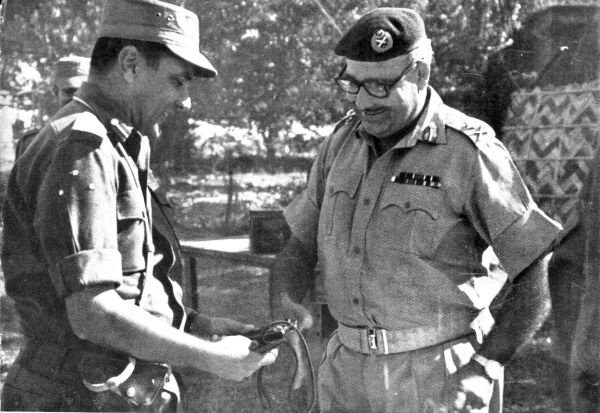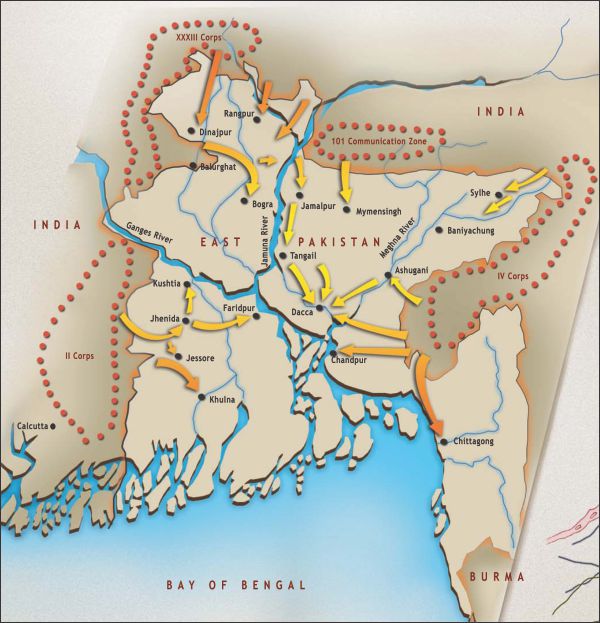The Liberation of Bangladesh
2 Corps
In the southwestern sector 2 Corps, under Lt Gen TN Raina, launched its thrust with 4 Mountain Division and 9 Infantry Division. It was well supported by a regiment plus a squadron of armour and was headed towards Kushtia and Jessore. By 6 December the well-entrenched Pakistani garrison in Jessore had apparently panicked and had pulled out. By 7 December the advancing columns had moved 30 km further up to Zenida. Magura, the next objective, was taken the next day. By 9 December, the leading elements were on the banks of the Madhumati river and preparations were underway for the capture of Kushtia. Contrary to the 2 Corps assessment, defences of Kushtia proved to be a tough nut to crack. The defenders held their ground for two long days before extricating themselves. By 12 December both Kushtia and the Hardinge Bridge, with some of its spans demolished, were in the bag. By then Indian forces were being concentrated for an assault on Daulatpur, a town close to Khulna. Operations for reducing Daulatpur were still in progress when the cease-fire came into effect. With hindsight, it appears that 2 Corps may have achieved more spectacular results if it had made a push towards Dacca once Jessore and Zenida had fallen.
33 Corps
Lt Gen ML Thapan, commanding 33 Corps, had 20 Mountain Division and two independent brigade groups. He was also permitted to commit one brigade of 6 Mountain Division, located in the Siliguri corridor, with a rider to ensure that it would be reverted within 48 hours if necessary. The Corps plan in a nutshell was to launch two brigades from the north towards Dinajpur and Rangpur. The divisional thrust from the west was to bypass Hilli from the north and then swing south to capture Bogra. The northern thrusts made spectacular progress. Their dash and determination totally surprised the defenders. By 9 December, Dinajpur had been contacted. Garrisons at Saidpur and Rangpur had been tied down. The divisional thrust also made steady progress. By 4 December, it had captured Charkai, 11 km inside. While positions immediately to the north of Hilli were still being fought for, advancing columns had moved further towards Nawabganj. It was captured mainly by the Mukti Bahini. By 7 December road Rangpur – Bogra had been severed. The same day, Maj Gen Shah, GOC 16 Pakistan Infantry Division, and his party were ambushed. However, the General managed to avoid capture. The thrust was, thereafter, developed due south towards Gobindganj and Bogra. In the meantime, Hilli had finally been captured on 11 December. It was one of the hardest fought battles of the eastern theatre. By 14 December, a roadblock had been established south of Bogra and parts of the township had been captured. Fierce fighting continued as the defenders shrank into the inner core of the built up area. However, all of them surrendered on 16 December 1971.
101 Communication Zone
Further to the east of 33 Corps was the area of operations of 101 Communication Zone. Both sides had assigned the lowest priority to this sector. Maj Gen GS Gill had just about two brigades to launch his thrust against a weak enemy brigade holding Jamalpur and Mymensingh strong points. His main effort was to head towards Jamalpur. The Pakistani outpost at Kamalpur surrendered on 4 December. Bakshiganj further south withdrew soon on being attacked. On 5 December Maj Gen GS Gill sustained injuries as his jeep went over a mine. He had to be evacuated and was replaced by Maj Gen GC Nagra. By 9 December, one more brigade, had been allotted to this sector and all was set for the capture of Jamalpur. That is when the Pakistani garrisons of Jamalpur and Mymensingh were ordered back for the close defence of Dacca. Thus, both these towns were in Indian hands on 11 December. That very evening a para drop took place at Tangail further south of Jamalpur towards Dacca. A link up was established on 12 December and the final push was made for Dacca. As it transpired, it was through this least priority sector that Dacca was entered first.


4 Corps
4 Corps in the east was under Lt Gen Sagat Singh and had 8, 23 and 57 Mountain Divisions on its order of battle. The Corps plan envisaged three Divisional thrusts to liberate all areas east of Meghna river, cut off rail and road communications to Chittagong, and force a crossing across Meghna to head for Dacca.
In the very opening stages, in the battle of Gangasagar near Akhaura, Lance Naik Albert Ekka of 14 Guards proved himself to be the bravest of the brave. During the attack he got wounded while single handedly silencing an enemy machine gun. Unmindful of his injuries, he charged on to clear yet another machine gun post by bayoneting the crew. He later succumbed to his wounds. He was posthumously awarded the Param Vir Chakra for most conspicuous bravery and became the only one to be so honoured in the eastern theatre during the war.
Akhaura fell on 5 December. By 7 December Brahmanbaria had been taken and the troops were racing towards Ashuganj. By then, in a daring heliborne operation, a battalion had been landed in Sylhet — a move that completely unnerved the Pakistanis. Comilla and Laksham were captured by 9 December. Efforts to hustle out the defenders from Ashuganj did not succeed and the bridge there could not be secured before it was blown by the Pakistanis in panic. However, using helicopters in the moonlit night, Meghna was ‘airbridged’. By 14 December more forces had got across Meghna using river craft. That day the first artillery shells were fired on Dacca. 4 Corps formations were on the outskirts of Dacca and Mynamati was still being fought for, when the Pakistani forces surrendered unconditionally.
Unconditional Surrender
Independent of these Corps thrusts, the air borne assault by 2 Para on 11 December near Tangail hastened the proceedings and the fall of Dacca. Lt Col KS Pannu, commanding the Para Group, was decorated with the Maha Vir Chakra for his determined combat leadership. On 12 December, a sea borne assault by a battalion group was launched towards Cox’s Bazar to prevent Pakistani troops from escaping into Burma. Both the Navy and the Air Force had achieved complete mastery of the sea and the air space and had supported the operations of the Eastern Command admirably.
After 12 December 1971, Gen Manekshaw had been sending messages to Niazi to surrender. Later, leaflets urging the same were also dropped. Radio frequencies on which HQ Eastern Command could be contacted were also made known. The deadline of 0900 hours on 16 December 1971 set for an unconditional surrender was extended to 1500 hours the same day at Niazi’s behest. That morning, Maj Gen Gandharva Nagra had already reached Niazi’s HQ and was soon joined by Maj Gen JFR Jacob, Chief of Staff of the Eastern Command. The Pakistani General was soon convinced that surrender was the only option.
In a hurriedly organised surrender ceremony at the Dacca Race Course, Lt Gen AAK Niazi signed the Instrument of Surrender and handed over his revolver to the victorious Indian commander before thousands of cheering and delirious crowds. Shouts of “Joi Bangla” rent the air. Lt Gen Jagjit Singh Aurora, the GOC-in-C, Eastern Command, accepted history’s greatest surrender since the end of the Second World War. Later that evening, Prime Minister Indira Gandhi announced to an ecstatic Lok Sabha that Dacca was the free capital of a free nation and offered a unilateral cease-fire in the western theatre with effect from December 17, 1971.
The audacity and speed of operations had kept the opponents off balance throughout. Over 90,000 personnel were taken prisoners of war. The Indian Army had achieved a stunning and memorable victory.



















